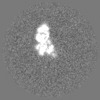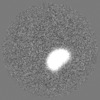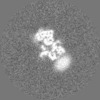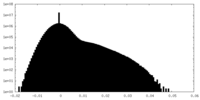[English] 日本語
 Yorodumi
Yorodumi- EMDB-36338: Cryo-EM structure of GluN1-2A NMDAR in complex with human Fab2G7 ... -
+ Open data
Open data
- Basic information
Basic information
| Entry |  | ||||||||||||||||||
|---|---|---|---|---|---|---|---|---|---|---|---|---|---|---|---|---|---|---|---|
| Title | Cryo-EM structure of GluN1-2A NMDAR in complex with human Fab2G7 in one fab conformation | ||||||||||||||||||
 Map data Map data | |||||||||||||||||||
 Sample Sample |
| ||||||||||||||||||
 Keywords Keywords | NMDAR / autoimmune encephalitis / MEMBRANE PROTEIN | ||||||||||||||||||
| Function / homology |  Function and homology information Function and homology informationglycine-gated cation channel activity / excitatory chemical synaptic transmission / directional locomotion / Synaptic adhesion-like molecules / protein localization to postsynaptic membrane / serotonin metabolic process / response to glycine / propylene metabolic process / sleep / Assembly and cell surface presentation of NMDA receptors ...glycine-gated cation channel activity / excitatory chemical synaptic transmission / directional locomotion / Synaptic adhesion-like molecules / protein localization to postsynaptic membrane / serotonin metabolic process / response to glycine / propylene metabolic process / sleep / Assembly and cell surface presentation of NMDA receptors / regulation of monoatomic cation transmembrane transport / NMDA glutamate receptor activity / Neurexins and neuroligins / NMDA selective glutamate receptor complex / glutamate binding / ligand-gated sodium channel activity / neurotransmitter receptor complex / glutamate receptor signaling pathway / calcium ion transmembrane import into cytosol / protein heterotetramerization / glycine binding / startle response / positive regulation of reactive oxygen species biosynthetic process / dopamine metabolic process / monoatomic cation transmembrane transport / Negative regulation of NMDA receptor-mediated neuronal transmission / Unblocking of NMDA receptors, glutamate binding and activation / positive regulation of calcium ion transport into cytosol / Long-term potentiation / excitatory synapse / monoatomic ion channel complex / monoatomic cation transport / regulation of neuronal synaptic plasticity / positive regulation of excitatory postsynaptic potential / synaptic cleft / positive regulation of synaptic transmission, glutamatergic / calcium ion homeostasis / MECP2 regulates neuronal receptors and channels / glutamate-gated calcium ion channel activity / neurogenesis / EPHB-mediated forward signaling / sensory perception of pain / ionotropic glutamate receptor signaling pathway / Ras activation upon Ca2+ influx through NMDA receptor / sodium ion transmembrane transport / synaptic membrane / cytoplasmic vesicle membrane / response to amphetamine / regulation of membrane potential / transmitter-gated monoatomic ion channel activity involved in regulation of postsynaptic membrane potential / excitatory postsynaptic potential / synaptic transmission, glutamatergic / protein catabolic process / postsynaptic density membrane / brain development / visual learning / regulation of synaptic plasticity / negative regulation of protein catabolic process / calcium ion transmembrane transport / response to wounding / memory / long-term synaptic potentiation / terminal bouton / synaptic vesicle / signaling receptor activity / amyloid-beta binding / presynaptic membrane / RAF/MAP kinase cascade / response to ethanol / dendritic spine / chemical synaptic transmission / postsynaptic membrane / learning or memory / calmodulin binding / neuron projection / postsynaptic density / positive regulation of apoptotic process / response to xenobiotic stimulus / calcium ion binding / synapse / dendrite / endoplasmic reticulum membrane / protein-containing complex binding / glutamatergic synapse / cell surface / positive regulation of transcription by RNA polymerase II / zinc ion binding / plasma membrane / cytoplasm Similarity search - Function | ||||||||||||||||||
| Biological species |  Homo sapiens (human) Homo sapiens (human) | ||||||||||||||||||
| Method | single particle reconstruction / cryo EM / Resolution: 4.3 Å | ||||||||||||||||||
 Authors Authors | Wang H / Zhu S | ||||||||||||||||||
| Funding support |  China, 5 items China, 5 items
| ||||||||||||||||||
 Citation Citation |  Journal: Nat Struct Mol Biol / Year: 2024 Journal: Nat Struct Mol Biol / Year: 2024Title: Structural basis for antibody-mediated NMDA receptor clustering and endocytosis in autoimmune encephalitis. Authors: Han Wang / Chun Xie / Bo Deng / Jinjun Ding / Na Li / Zengwei Kou / Mengmeng Jin / Jie He / Qinrui Wang / Han Wen / Jinbao Zhang / Qinming Zhou / Sheng Chen / Xiangjun Chen / Ti-Fei Yuan / Shujia Zhu /  Abstract: Antibodies against N-methyl-D-aspartate receptors (NMDARs) are most frequently detected in persons with autoimmune encephalitis (AE) and used as diagnostic biomarkers. Elucidating the structural ...Antibodies against N-methyl-D-aspartate receptors (NMDARs) are most frequently detected in persons with autoimmune encephalitis (AE) and used as diagnostic biomarkers. Elucidating the structural basis of monoclonal antibody (mAb) binding to NMDARs would facilitate the development of targeted therapy for AE. Here, we reconstructed nanodiscs containing green fluorescent protein-fused NMDARs to label and sort individual immune B cells from persons with AE and further cloned and identified mAbs against NMDARs. This allowed cryo-electron microscopy analysis of NMDAR-Fab complexes, revealing that autoantibodies bind to the R1 lobe of the N-terminal domain of the GluN1 subunit. Small-angle X-ray scattering studies demonstrated NMDAR-mAb stoichiometry of 2:1 or 1:2, structurally suitable for mAb-induced clustering and endocytosis of NMDARs. Importantly, these mAbs reduced the surface NMDARs and NMDAR-mediated currents, without tonically affecting NMDAR channel gating. These structural and functional findings imply that the design of neutralizing antibody binding to the R1 lobe of NMDARs represents a potential therapy for AE treatment. | ||||||||||||||||||
| History |
|
- Structure visualization
Structure visualization
| Supplemental images |
|---|
- Downloads & links
Downloads & links
-EMDB archive
| Map data |  emd_36338.map.gz emd_36338.map.gz | 166.5 MB |  EMDB map data format EMDB map data format | |
|---|---|---|---|---|
| Header (meta data) |  emd-36338-v30.xml emd-36338-v30.xml emd-36338.xml emd-36338.xml | 20.5 KB 20.5 KB | Display Display |  EMDB header EMDB header |
| Images |  emd_36338.png emd_36338.png | 44.5 KB | ||
| Filedesc metadata |  emd-36338.cif.gz emd-36338.cif.gz | 7 KB | ||
| Others |  emd_36338_half_map_1.map.gz emd_36338_half_map_1.map.gz emd_36338_half_map_2.map.gz emd_36338_half_map_2.map.gz | 140.6 MB 140.5 MB | ||
| Archive directory |  http://ftp.pdbj.org/pub/emdb/structures/EMD-36338 http://ftp.pdbj.org/pub/emdb/structures/EMD-36338 ftp://ftp.pdbj.org/pub/emdb/structures/EMD-36338 ftp://ftp.pdbj.org/pub/emdb/structures/EMD-36338 | HTTPS FTP |
-Validation report
| Summary document |  emd_36338_validation.pdf.gz emd_36338_validation.pdf.gz | 1 MB | Display |  EMDB validaton report EMDB validaton report |
|---|---|---|---|---|
| Full document |  emd_36338_full_validation.pdf.gz emd_36338_full_validation.pdf.gz | 1 MB | Display | |
| Data in XML |  emd_36338_validation.xml.gz emd_36338_validation.xml.gz | 14.9 KB | Display | |
| Data in CIF |  emd_36338_validation.cif.gz emd_36338_validation.cif.gz | 17.7 KB | Display | |
| Arichive directory |  https://ftp.pdbj.org/pub/emdb/validation_reports/EMD-36338 https://ftp.pdbj.org/pub/emdb/validation_reports/EMD-36338 ftp://ftp.pdbj.org/pub/emdb/validation_reports/EMD-36338 ftp://ftp.pdbj.org/pub/emdb/validation_reports/EMD-36338 | HTTPS FTP |
-Related structure data
| Related structure data |  8jj2MC  8jizC  8jj0C  8jj1C M: atomic model generated by this map C: citing same article ( |
|---|---|
| Similar structure data | Similarity search - Function & homology  F&H Search F&H Search |
- Links
Links
| EMDB pages |  EMDB (EBI/PDBe) / EMDB (EBI/PDBe) /  EMDataResource EMDataResource |
|---|---|
| Related items in Molecule of the Month |
- Map
Map
| File |  Download / File: emd_36338.map.gz / Format: CCP4 / Size: 178 MB / Type: IMAGE STORED AS FLOATING POINT NUMBER (4 BYTES) Download / File: emd_36338.map.gz / Format: CCP4 / Size: 178 MB / Type: IMAGE STORED AS FLOATING POINT NUMBER (4 BYTES) | ||||||||||||||||||||||||||||||||||||
|---|---|---|---|---|---|---|---|---|---|---|---|---|---|---|---|---|---|---|---|---|---|---|---|---|---|---|---|---|---|---|---|---|---|---|---|---|---|
| Projections & slices | Image control
Images are generated by Spider. | ||||||||||||||||||||||||||||||||||||
| Voxel size | X=Y=Z: 1.08 Å | ||||||||||||||||||||||||||||||||||||
| Density |
| ||||||||||||||||||||||||||||||||||||
| Symmetry | Space group: 1 | ||||||||||||||||||||||||||||||||||||
| Details | EMDB XML:
|
-Supplemental data
-Half map: #1
| File | emd_36338_half_map_1.map | ||||||||||||
|---|---|---|---|---|---|---|---|---|---|---|---|---|---|
| Projections & Slices |
| ||||||||||||
| Density Histograms |
-Half map: #2
| File | emd_36338_half_map_2.map | ||||||||||||
|---|---|---|---|---|---|---|---|---|---|---|---|---|---|
| Projections & Slices |
| ||||||||||||
| Density Histograms |
- Sample components
Sample components
-Entire : Cryo-EM structure of GluN1-2A NMDAR in complex with human Fab28
| Entire | Name: Cryo-EM structure of GluN1-2A NMDAR in complex with human Fab28 |
|---|---|
| Components |
|
-Supramolecule #1: Cryo-EM structure of GluN1-2A NMDAR in complex with human Fab28
| Supramolecule | Name: Cryo-EM structure of GluN1-2A NMDAR in complex with human Fab28 type: cell / ID: 1 / Parent: 0 / Macromolecule list: #1-#4 |
|---|---|
| Source (natural) | Organism:  Homo sapiens (human) Homo sapiens (human) |
-Macromolecule #1: Glutamate receptor ionotropic, NMDA 2A
| Macromolecule | Name: Glutamate receptor ionotropic, NMDA 2A / type: protein_or_peptide / ID: 1 / Number of copies: 2 / Enantiomer: LEVO |
|---|---|
| Source (natural) | Organism:  Homo sapiens (human) Homo sapiens (human) |
| Molecular weight | Theoretical: 94.136016 KDa |
| Recombinant expression | Organism:  Homo sapiens (human) Homo sapiens (human) |
| Sequence | String: MGRVGYWTLL VLPALLVWRG PAPSAAAEKG PPALNIAVML GHSHDVTERE LRTLWGPEQA AGLPLDVNVV ALLMNRTDPK SLITHVCDL MSGARIHGLV FGDDTDQEAV AQMLDFISSH TFVPILGIHG GASMIMADKD PTSTFFQFGA SIQQQATVML K IMQDYDWH ...String: MGRVGYWTLL VLPALLVWRG PAPSAAAEKG PPALNIAVML GHSHDVTERE LRTLWGPEQA AGLPLDVNVV ALLMNRTDPK SLITHVCDL MSGARIHGLV FGDDTDQEAV AQMLDFISSH TFVPILGIHG GASMIMADKD PTSTFFQFGA SIQQQATVML K IMQDYDWH VFSLVTTIFP GYREFISFVK TTVDNSFVGW DMQNVITLDT SFEDAKTQVQ LKKIHSSVIL LYCSKDEAVL IL SEARSLG LTGYDFFWIV PSLVSGNTEL IPKEFPSGLI SVSYDDWDYS LEARVRDGIG ILTTAASSML EKFSYIPEAK ASC YGQMER PEVPMHTLHP FMVNVTWDGK DLSFTEEGYQ VHPRLVVIVL NKDREWEKVG KWENHTLSLR HAVWPRYKSF SDCE PDDNH LSIVTLEEAP FVIVEDIDPL TETCVRNTVP CRKFVKINNS TNEGMNVKKC CKGFCIDILK KLSRTVKFTY DLYLV TNGK HGKKVNNVWN GMIGEVVYQR AVMAVGSLTI NEERSEVVDF SVPFVETGIS VMVSRSNGTV SPSAFLEPFS ASVWVM MFV MLLIVSAIAV FVFEYFSPVG YNRNLAKGKA PHGPSFTIGK AIWLLWGLVF NNSVPVQNPK GTTSKIMVSV WAFFAVI FL ASYTANLAAF MIQEEFVDQV TGLSDKKFQR PHDYSPPFRF GTVPNGSTER NIRNNYPYMH QYMTKFNQKG VEDALVSL K TGKLDAFIYD AAVLNYKAGR DEGCKLVTIG SGYIFATTGY GIALQKGSPW KRQIDLALLQ FVGDGEMEEL ETLWLTGIC HNEKNEVMSS QLDIDNMAGV FYMLAAAMAL SLITFIWEHL F UniProtKB: Glutamate receptor ionotropic, NMDA 2A |
-Macromolecule #2: Glutamate receptor ionotropic, NMDA 1
| Macromolecule | Name: Glutamate receptor ionotropic, NMDA 1 / type: protein_or_peptide / ID: 2 / Number of copies: 2 / Enantiomer: LEVO |
|---|---|
| Source (natural) | Organism:  Homo sapiens (human) Homo sapiens (human) |
| Molecular weight | Theoretical: 95.236078 KDa |
| Recombinant expression | Organism:  Homo sapiens (human) Homo sapiens (human) |
| Sequence | String: MSTMRLLTLA LLFSCSVARA ACDPKIVNIG AVLSTRKHEQ MFREAVNQAN KRHGSWKIQL NATSVTHKPN AIQMALSVCE DLISSQVYA ILVSHPPTPN DHFTPTPVSY TAGFYRIPVL GLTTRMSIYS DKSIHLSFLR TVPPYSHQSS VWFEMMRVYS W NHIILLVS ...String: MSTMRLLTLA LLFSCSVARA ACDPKIVNIG AVLSTRKHEQ MFREAVNQAN KRHGSWKIQL NATSVTHKPN AIQMALSVCE DLISSQVYA ILVSHPPTPN DHFTPTPVSY TAGFYRIPVL GLTTRMSIYS DKSIHLSFLR TVPPYSHQSS VWFEMMRVYS W NHIILLVS DDHEGRAAQK RLETLLEERE SKAEKVLQFD PGTKNVTALL MEAKELEARV IILSASEDDA ATVYRAAAML NM TGSGYVW LVGEREISGN ALRYAPDGIL GLQLINGKNE SAHISDAVGV VAQAVHELLE KENITDPPRG CVGNTNIWKT GPL FKRVLM SSKYADGVTG RVEFNEDGDR KFANYSIMNL QNRKLVQVGI YNGTHVIPND RKIIWPGGET EKPRGYQMST RLKI VTIHQ EPFVYVKPTL SDGTCKEEFT VNGDPVKKVI CTGPNDTSPG SPRHTVPQCC YGFCIDLLIK LARTMNFTYE VHLVA DGKF GTQERVNNSN KKEWNGMMGE LLSGQADMIV APLTINNERA QYIEFSKPFK YQGLTILVKK EIPRSTLDSF MQPFQS TLW LLVGLSVHVV AVMLYLLDRF SPFGRFKVNS EEEEEDALTL SSAMWFSWGV LLNSGIGEGA PRSFSARILG MVWAGFA MI IVASYTANLA AFLVLDRPEE RITGINDPRL RNPSDKFIYA TVKQSSVDIY FRRQVELSTM YRHMEKHNYE SAAEAIQA V RDNKLHAFIW DSAVLEFEAS QKCDLVTTGE LFFRSGFGIG MRKDSPWKQN VSLSILKSHE NGFMEDLDKT WVRYQECDS RSNAPATLTF ENMAGVFMLV AGGIVAGIFL IFIEIAYKRH KDARRKQ UniProtKB: Glutamate receptor ionotropic, NMDA 1 |
-Macromolecule #3: Fab2G7 Heavy Chain
| Macromolecule | Name: Fab2G7 Heavy Chain / type: protein_or_peptide / ID: 3 / Number of copies: 1 / Enantiomer: LEVO |
|---|---|
| Source (natural) | Organism:  Homo sapiens (human) Homo sapiens (human) |
| Molecular weight | Theoretical: 26.893043 KDa |
| Recombinant expression | Organism:  Homo sapiens (human) Homo sapiens (human) |
| Sequence | String: MDWTWSILFL VAAPTGAHSQ VQLVQSGAEV RKPGASVKVS CRASGYSFTG YYVHWVRQAP GQGLEWLGWI NPNTGGTDYS QKFQGRVTM TRDTSITTAY VELSSLISDD TAVYYCARDA TGAASSPFDY WGQGTLVTVS SASTKGPSVF PLAPSSKSTS G GTAALGCL ...String: MDWTWSILFL VAAPTGAHSQ VQLVQSGAEV RKPGASVKVS CRASGYSFTG YYVHWVRQAP GQGLEWLGWI NPNTGGTDYS QKFQGRVTM TRDTSITTAY VELSSLISDD TAVYYCARDA TGAASSPFDY WGQGTLVTVS SASTKGPSVF PLAPSSKSTS G GTAALGCL VKDYFPEPVT VSWNSGALTS GVHTFPAVLQ SSGLYSLSSV VTVPSSSLGT QTYICNVNHK PSNTKVDKRV EP KSCDKTH TCPPCP |
-Macromolecule #4: Fab2G7 Light Chain
| Macromolecule | Name: Fab2G7 Light Chain / type: protein_or_peptide / ID: 4 / Number of copies: 1 / Enantiomer: LEVO |
|---|---|
| Source (natural) | Organism:  Homo sapiens (human) Homo sapiens (human) |
| Molecular weight | Theoretical: 25.764998 KDa |
| Recombinant expression | Organism:  Homo sapiens (human) Homo sapiens (human) |
| Sequence | String: MDMRVPAQLL GLLLLWLRGA RCDIQMTQSP STLSASVGDR VTITCRASQS ISSWLAWYQQ RPGQAPKLLI YMASTLQTGV PSRFSGSGS GTEFTLTISS LQPDDFATYY CQHYKSYSFG PGTKVDIKRT VAAPSVFIFP PSDEQLKSGT ASVVCLLNNF Y PREAKVQW ...String: MDMRVPAQLL GLLLLWLRGA RCDIQMTQSP STLSASVGDR VTITCRASQS ISSWLAWYQQ RPGQAPKLLI YMASTLQTGV PSRFSGSGS GTEFTLTISS LQPDDFATYY CQHYKSYSFG PGTKVDIKRT VAAPSVFIFP PSDEQLKSGT ASVVCLLNNF Y PREAKVQW KVDNALQSGN SQESVTEQDS KDSTYSLSST LTLSKADYEK HKVYACEVTH QGLSSPVTKS FNRGEC |
-Macromolecule #6: 2-acetamido-2-deoxy-beta-D-glucopyranose
| Macromolecule | Name: 2-acetamido-2-deoxy-beta-D-glucopyranose / type: ligand / ID: 6 / Number of copies: 8 / Formula: NAG |
|---|---|
| Molecular weight | Theoretical: 221.208 Da |
| Chemical component information | 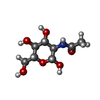 ChemComp-NAG: |
-Experimental details
-Structure determination
| Method | cryo EM |
|---|---|
 Processing Processing | single particle reconstruction |
| Aggregation state | particle |
- Sample preparation
Sample preparation
| Buffer | pH: 8 |
|---|---|
| Vitrification | Cryogen name: ETHANE / Chamber humidity: 100 % / Chamber temperature: 281 K / Instrument: FEI VITROBOT MARK III |
- Electron microscopy
Electron microscopy
| Microscope | FEI TITAN KRIOS |
|---|---|
| Image recording | Film or detector model: GATAN K3 (6k x 4k) / Average electron dose: 70.0 e/Å2 |
| Electron beam | Acceleration voltage: 300 kV / Electron source:  FIELD EMISSION GUN FIELD EMISSION GUN |
| Electron optics | Illumination mode: FLOOD BEAM / Imaging mode: BRIGHT FIELD / Nominal defocus max: 2.5 µm / Nominal defocus min: 0.8 µm |
| Experimental equipment |  Model: Titan Krios / Image courtesy: FEI Company |
 Movie
Movie Controller
Controller






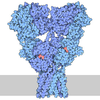







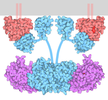
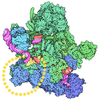

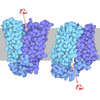
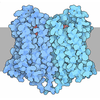
 Z (Sec.)
Z (Sec.) Y (Row.)
Y (Row.) X (Col.)
X (Col.)









